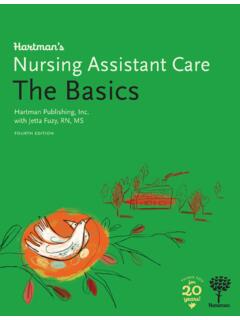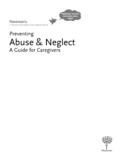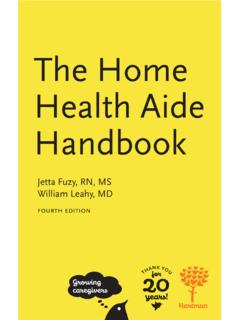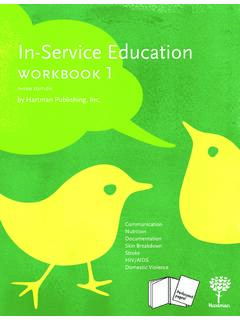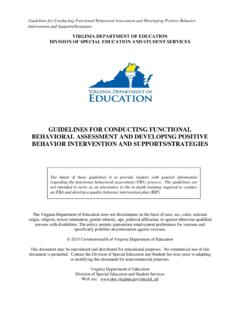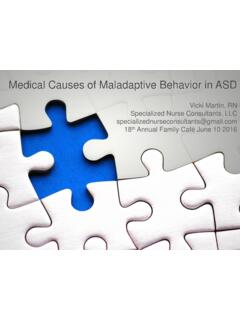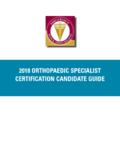Transcription of Prevention and Management of Aggressive Behavior
1 Helping in-service educators since 1994!Hartman's In-Service Education SourceBook SeriesWorkplace ViolencePrevention and Management of Aggressive BehaviorSharon Edwards, RN, MSN, CS Albuquerque, NMWorkplace ViolencePrevention and Management ofAGGRESSIVE BEHAVIORC ontributorSharon Edwards, RN, MSN, CSClinical Nurse SpecialistPennington Gap, VirginiaCo-ContributorsCarolyn Shular, MSN, RN, CSClinical Nurse SpecialistIndian Path PavilionKingsport, TennesseeJohn Shupe, MSN, RN, CSClinical Nurse SpecialistIndian Path PavilionKingsport, TennesseeThe publisher gratefully acknowledges the followingreviewers who contributed to this material:Tanya Dickson, RNAssistant Director of NursingRolling Hills Rehabilitation Center & Special Care HomeSparta, WisconsinKaren A. Hergert, RN, MSDirector of Staff EducationMaristhill Nursing & Rehabilitation CenterWaltham, MassachusettsNOTICE TO THE READERT hough the guidelines contained in this text are based onconsultations with healthcare professionals, they should not beconsidered absolute recommendations.
2 The instructor andreaders should follow employer, local, state, and federalguidelines concerning healthcare practices. These guidelineschange, and it is the reader s responsibility to be aware ofthese changes and of the policies and procedures of her or hishealthcare publisher, author, editors, and reviewers cannotaccept any responsibility for errors or omission or for anyconsequences from application of the information in this bookand make no warranty, express or implied, with respect to thecontents of this does not warrant or guarantee any of theproducts described herein or perform any analysis inconnection with any of the product information : Sharon Edwards, RN, MSN, CSCo-Contributors: Carolyn Shular, MSN, RN, CS John Shupe, MSN, RN, CSDevelopment Editor: Celia McIntireCopy Editor: Susan AlvareComposition: Celia McIntireIllustration: Thaddeus CastilloISBN 1-888343-26-5 1999 Hartman Publishing, Inc. All rightsreserved. Limited permission to photocopy thelabeled handouts in this text is granted to directpurchasers of this book from the can only be made for employees orstudents at ONE LOCATION of a multi-siteemployer or school.
3 No other part of thisbook may be reproduced, in any form or byany means, without permission in writing fromthe of ContentsFYI5 Learning Objective 5: Define therapeuticIntroduction and Assessment6 Handouts:Assessment A (8)Assessment A Answer Key (9)Note-Taking Worksheet (10)Transparency:Targeted Population (15)Learning Objective 1: Define aggression anddescribe the cycle of Aggressive and violentbehavior16 Transparencies:Definition of Aggression (18)Learning Objective 7: List two (2)Types of Aggression (19)Aggression Cycle (20)Restraint Regulations (21)Learning Objective 2: Identify three (3)reasons for Aggressive or violent Behavior 22 Transparencies:Reasons for Aggressive Behavior (24)Factors for Aggressive Acts (25)Learning Objective 3: Identify two (2)legal and ethical issues26 Transparency:Legal and Ethical Issues (27)Learning Objective 4: List three (3) factorsto consider in assessing a situation foraggression 28 Transparencies:Interact, Don't React (31)Factors for Therapeutic Interventions (32)Characteristics/Skills (33)intervention34 Transparencies:Settings/Situations (36)Psychiatric Considerations (37)Geriatric Considerations (38)Home Care Considerations (39)Learning Objective 6: Describe anintervention for an anxious state40 Transparencies:Problem-Solving Steps (42)Techniques to Deal with Anxious Residents (43)interventions for verbal aggression44 Transparencies:Nonverbal Clues for Decreasing Anxiety (46)Nonverbal Clues for Increasing Anxiety (47)Interventions for Verbal Aggression (48)Learning Objective 8: Demonstratetwo (2) interventions for physicalaggression49 Transparencies.
4 Dealing with Physical Aggression (51)Common Attacks (52)Biting (53)Hitting (54)Kicking (55)Pulling Hair (56)Throwing Objects (57)Learning Objective 9: Identify four (4)considerations in using restraints58 Handout:Sample Restraint Records (63)Transparencies:Protective Devices vs. Restraints (60)Restraint Considerations (61)Restraint Guidelines (62)Learning Objective 10: Describe thebenefit of debriefing or cooling down64 Transparencies:De-escalating Behavior (66)PTSD Symptoms (67)Debriefing Questions (68)Learning Objective 11: Identify the criticalfactor in Prevention and Management ofaggressive or violent behavior69 Transparencies:Key Component (70)Main Areas of Awareness (71)Closing and Assessment72 Handouts:Assessment B (74)Assessment B Answer Key (76)Transparency:Steps for Dealing with PotentialAggression (73)References77In-Service Evaluation Form78 Certificate of Completion79 Record Keeping Form80 5 FYIs health care expands and our populationThis in-service can be divided into three sections asAages, many older adults are discoveringfollows:that the reduction of extended families isleaving them with few options as they become1.
5 Introduction - Learning Objective 4older and more dependent. As a result, home care,2. Learning Objective 5 - 7assisted living facilities, and nursing homes have3. Learning Objective 8 - 11become increasingly necessary. The older adult srealization of limited abilities, both physically andPlease note that limited permission is granted toemotionally, often contributes to frustration, fear,photocopy the handouts for use at the site originallyand potentially Aggressive Behavior . Healthcarepurchasing this in-service. Photocopying other partsworkers are faced with difficulties, such asof this in-service, including the lesson plan, isworkplace violence, that were more limited in theexpressly in-service focuses on violent or aggressiveyour group. Consider using different colors ofbehavior and ways to prevent or minimize it in thepaper to organize the different handouts or to makework setting. While we address aggressivesome stand , the information contained in thisSourceBook is intended to be used for preventionConvert transparency masters to acetates for useand assessment.
6 The issues of workplace violencewith an overhead projector. You can do this byare the same for both long-term care facilities andpurchasing transparency film at an office supplyhome health agencies, with some differences forstore and photocopying the transparency mastershome care due to the different environment. Inonto the acetates, or you can have a copy companyrespect for the nursing home and assisted livingdo it for you. If overhead projection is notindividuals, the term resident will be used. Inconvenient for your presentation area, you mayaddition, HCFA has regulations in their condition ofwish to copy the information from the transparencyparticipation (nursing homes) that regulate the usemasters onto a chalkboard or flip psychotropic medications and the use ofmechanical restraints. Hopefully, with earlyWe hope you find this in-service helpful. And, asintervention, chemical and manual restraints can bealways, we welcome your comments andavoided or greatly manual is intended to deal with aggressivebehavior.
7 If more instruction and physicalintervention are needed, such as take downs orseclusion, there are several programs available.(Consult your mental health agency.)To use handouts, photocopy the number needed forIntroduction and Assessment 6 Introduction and AssessmentEstimated Time:20 minutesTools:Handout Intro-1 Assessment AHandout Intro-2 Assessment A Answer KeyHandout Intro-3 Note-Taking WorksheetTransparency Intro-1 Targeted PopulationLearning Activity:IntroductionThe purpose of this in-service is to educate healthcare workers about preventionand Management of violence and aggression. The goal is to reduce the frequencyand degree of violent or Aggressive Behavior among the persons in their care byteaching techniques to prevent and manage the Behavior when it Activity:AssessmentDistributeHandout Intro-1 Assessment AAllow participants enough time to complete the Activity:Lecture and DiscussionAsk the following questions for discussion: Have any of you been involved in a violent or Aggressive situation?
8 What happened? Was the outcome negative or positive? What would you have done differently? What are your views now about a similar situation? Did you now have fears about aggression? Did you feel that the Aggressive individual was being mean to you?Allow (as time permits) the participants to discuss these situations and then ask forfeedback from the remainder of the group. Answer any questions that may Intro-3 Note-TakingWorksheetAdvise the participants that taking notes during the lectures and discussions willhelp them to remember the information and provide a resource to refer to later. Introduction and Assessment 7 In the healthcare system, it is estimated that about 225,000 to 300,000 acts ofaggression occur annually. About two-thirds (2/3) of the total number of reportedincidents are directed towards the healthcare the following question: Why do you think healthcare workers are the target of Aggressive and violentbehavior from the persons in our care?
9 (Answers include: healthcare worker isoften the bearer of bad news or the most convenient person on which tovent frustrations)No act of aggression is completely senseless. There are reasons behind theaggressive or violent Behavior , and it is our job to discover what those reasons areand use that knowledge to prevent Aggressive Behavior in the participants to discuss the following: Think about a situation in which you would feel threatened. What would you do to protect yourself or your loved ones?Close the discussion by pointing out that we are all capable of aggression if we feelthreatened enough!DisplayTransparencyIntro-1 Targeted PopulationThe targeted populations that healthcare staff work with in long-term carefacilities, assisted living facilities, and home health agencies include individuals whoare: Elderly Chronically ill Chronically in pain (sometimes unmanaged) Experiencing multiple health difficulties Mentally illBriefly discuss the various aspects of mental illness: Dual diagnosis - a diagnosis of both mental illness and one of the following: - chemical dependency- mental retardation- medical illness Dementia Alzheimer s diseaseHandout Intro-1 8 Assessment AName: _____ Date: _____Instructor s Name: _____True or False.
10 For each of the following statements, write T for true or F for ___ People are mean and this is why they are Aggressive towards ___ Aggression occurs without ___ Residents are only Aggressive towards those healthcare workers that they don t ___ All acts of aggression or violence are clearly directed at a specific ___ Aggression is a result of ___ Aggression is a learned ___ Each of us has a safety personal space of about three ___ Healthcare workers have a legal responsibility to do no harm. 9. ___ We can choose to interact with aggression rather than react to Our previous experience will influence how we respond to Residents will present clues before becoming Establishing routine times for eating, bathing, and other activities can reduce Difficulty with seeing or hearing can be a factor leading to The first stage of aggression is increased The most important factor to prevent aggression is to listen to the Too many people talking can increase anxiety and frustration for the Statements to the agitated resident/client should only be stated When the resident/client has become physically Aggressive , he/she can still logically If a staff member is involved in an Aggressive event, he/she may develop Post Traumatic The key component of Prevention and Management of Aggressive Behavior is Intro-3 9 Assessment A Answer Key1.


